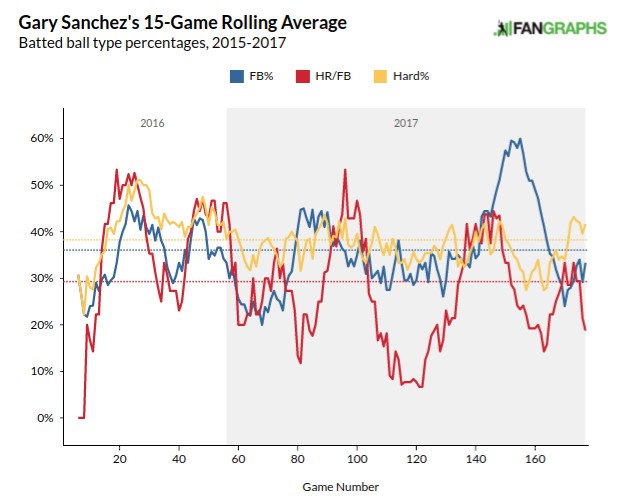2018 MLB Draft Guide Player Profile: Gary Sanchez (Free Preview)
.jpg)
Published: Mar 27, 2018
| Age: | 25 |
| Bats/Throws: | R/R |
| Height/Weight: | 6'2", 230 lbs |
| Position: | Catcher |
It’s rare for a player to sit in a tier of his own, but at catcher this year, Gary Sanchez represents the clear number one in fantasy at his position. In spite of missing a month due to a biceps injury last April, Sanchez still launched a career high 33 home runs during his first full season in the majors. While defense may be his downfall as a catcher, Sanchez did spend his off-season working on flexibility in order to allow him to squat lower behind the plate and improve recovery time after catching a game.
Targeting Sanchez in drafts or auctions will not come with a cheap price tag. Although power numbers continue to rise in baseball, Sanchez represents the gold standard in home runs at catcher hitting amidst a Yankees lineup which could set some records on offense this season. Suffice it to say, with health, counting statistics such as runs and RBI should be plentiful for Sanchez, punctuating his overall worth in fantasy.
Accruing 471 at-bats in 2017, Sanchez scored 79 runs with 90 RBI, two stolen bases and hit a respectable .278/.345/.531 slash line. While Sanchez will not provide batting average insurance like Buster Posey, he’s better than many give him credit for. For example, according to xSTATS.org, the expected slash for Sanchez last year of .294/.360/.538 exceeds his actual numbers. This proves to be rare. Also, could there be room for growth?
Transitioning to his expected BABIP of .334, Sanchez recorded an actual BABIP of 304, so positive migration or some luck translates to better results this year. Sanchez finished with a weighted on-base average (wOBA) of .368 last year but his expected on-base average of .377 still allows for improvement.
Power hitters often come with biases against their plate discipline since many sell out to hit home runs. Sanchez enters his Age-25 season healthy, slated to hit in the heart of the batting order. He also reduced his strikeout rate last season, lowered his swinging strike percentage, increased contact and kept his chase rate stable. Due to his strength, Sanchez does not need to sell out for power. It comes naturally.
Another positive finding, Sanchez raised his fly ball percentage last year by 2.4 percent, hit more line drive (up five percent) and cut his ground ball rate by seven percent. Despite only playing two years in the majors, Sanchez displays encouraging results with room for growth. Here’s his 15-game rolling chart from Fangraphs with fly ball, home run per fly and hard hit percentages:

While most of this profile will focus on potential upside, it’s worth noting Sanchez displays a propensity to be streaky as evidenced above. There’s clear spikes in fly balls along with some complete craters in home run per fly ball rates. His hard hit percentage seems to vacillate, but he finished the season strong as reflected by his second half with 20 home runs in only 257 at-bats (one every 12.85) with a .564 slugging percentage and a .284 isolated power.
In spite of starting the season mired in a 3-for-20 slump with a home run in his first five games before being sidelined by injury, he finished strong. Before going into the Statcast data, here’s his spray chart from last year courtesy of MLBfarm.com:

While Sanchez does pull the ball over half of the time, he can hit the ball out of the park to any field. His average exit velocity on fly balls and line drives of 96 MPH punctuates this. Sanchez also recorded 153 balls in play with an exit velocity of 95 MPH+ out of 355 batted ball events, 43.1 percent of the time. More fly balls with a steady hard hit rate places Sanchez on the precipice of a potential step forward in power.
Lazy extrapolation would suggest all Sanchez needs to do is replicate his second half over a full season in order to reach 40 home runs. But it’s never this easy. All the underlying data along with the expected data from xSTATS do reinforce Sanchez could hit more than 33 home runs with a higher average if he reaches 525 at-bats with his home run per 12.85 at-bat pace after the break.
Due to the projection systems being close-packed, it’s not going to be worth going through all the aggregate numbers. They all foresee his home run total between 32-to-34 with 71-to-74 runs, 84-to-97 RBI and an average in the .267-to-.277 range. Because, even though Sanchez will enter his power peak years, he cannot carry over his batting average right?
This year will be a great barometer to see if Sanchez can conflate growing power with a better than palatable batting average at catcher. Only Johnny Bench, Roy Campanella, Mike Piazza, Javy Lopez and Todd Hundley have hit 40 home runs as a catcher. All of them, with the exception of Hundley, hit at least .270, which sets the bar high for Sanchez, but it’s within the realm of possibilities.
Paying the price point guided by the projections for Gary Sanchez set a realistic market and cements him as the number one player at his position in fantasy. However, unlike many, Sanchez could exceed his projections making him a potential difference maker for owners who invest.
Risk always comes into play since a catcher’s prone to injury, but with a full season and at least 525 at-bats, Sanchez could be the fifth one at his position to reach the 40 home run threshold.
----------------------------------------------------------------------------------------------------------------------------------
Statistical Credits:
Fangraphs.com, Baseball-Reference.com, xSTATS.org, MLBfarm.com
